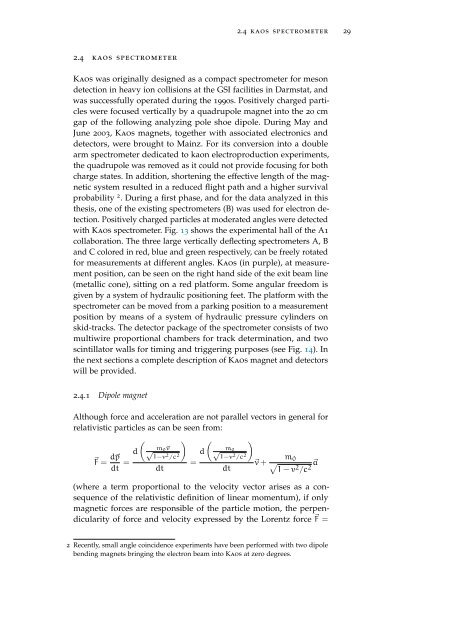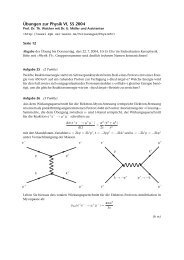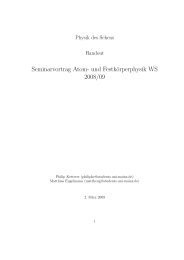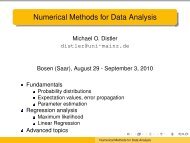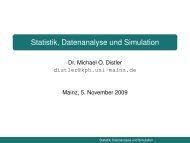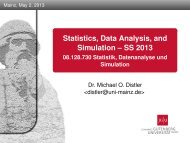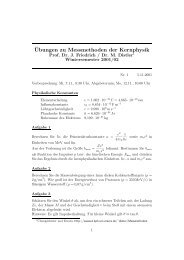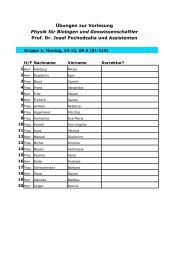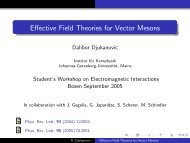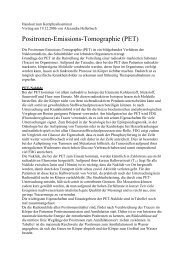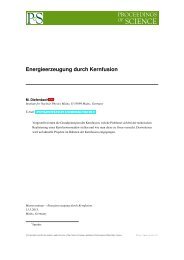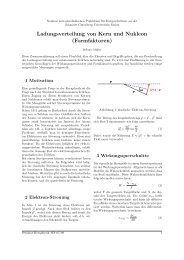A Classic Thesis Style - Johannes Gutenberg-Universität Mainz
A Classic Thesis Style - Johannes Gutenberg-Universität Mainz
A Classic Thesis Style - Johannes Gutenberg-Universität Mainz
You also want an ePaper? Increase the reach of your titles
YUMPU automatically turns print PDFs into web optimized ePapers that Google loves.
2.4 kaos spectrometer<br />
2.4 kaos spectrometer 29<br />
Kaos was originally designed as a compact spectrometer for meson<br />
detection in heavy ion collisions at the GSI facilities in Darmstat, and<br />
was successfully operated during the 1990s. Positively charged particles<br />
were focused vertically by a quadrupole magnet into the 20 cm<br />
gap of the following analyzing pole shoe dipole. During May and<br />
June 2003, Kaos magnets, together with associated electronics and<br />
detectors, were brought to <strong>Mainz</strong>. For its conversion into a double<br />
arm spectrometer dedicated to kaon electroproduction experiments,<br />
the quadrupole was removed as it could not provide focusing for both<br />
charge states. In addition, shortening the effective length of the magnetic<br />
system resulted in a reduced flight path and a higher survival<br />
probability 2 . During a first phase, and for the data analyzed in this<br />
thesis, one of the existing spectrometers (B) was used for electron detection.<br />
Positively charged particles at moderated angles were detected<br />
with Kaos spectrometer. Fig. 13 shows the experimental hall of the A1<br />
collaboration. The three large vertically deflecting spectrometers A, B<br />
and C colored in red, blue and green respectively, can be freely rotated<br />
for measurements at different angles. Kaos (in purple), at measurement<br />
position, can be seen on the right hand side of the exit beam line<br />
(metallic cone), sitting on a red platform. Some angular freedom is<br />
given by a system of hydraulic positioning feet. The platform with the<br />
spectrometer can be moved from a parking position to a measurement<br />
position by means of a system of hydraulic pressure cylinders on<br />
skid-tracks. The detector package of the spectrometer consists of two<br />
multiwire proportional chambers for track determination, and two<br />
scintillator walls for timing and triggering purposes (see Fig. 14). In<br />
the next sections a complete description of Kaos magnet and detectors<br />
will be provided.<br />
2.4.1 Dipole magnet<br />
Although force and acceleration are not parallel vectors in general for<br />
relativistic particles as can be seen from:<br />
�F = d�p<br />
dt =<br />
� �<br />
m0�v<br />
d √<br />
1−v2 /c2 dt<br />
=<br />
� �<br />
m0 d √<br />
1−v2 /c2 dt<br />
�v +<br />
m0<br />
� 1 − v 2 /c 2 �a<br />
(where a term proportional to the velocity vector arises as a consequence<br />
of the relativistic definition of linear momentum), if only<br />
magnetic forces are responsible of the particle motion, the perpendicularity<br />
of force and velocity expressed by the Lorentz force �F =<br />
2 Recently, small angle coincidence experiments have been performed with two dipole<br />
bending magnets bringing the electron beam into Kaos at zero degrees.


